It’s hard to miss Eastern tiger swallowtail butterflies fluttering through your garden. These large and charismatic flower visitors are common from late spring through early fall, alighting on a variety of plants that offer nectar. Females are also looking for appropriate host plants to lay their eggs. As with any butterfly or moth, to lure and keep swallowtails in your garden, you need to provide food for the adults and caterpillars. Learn more about some of their favorite nectar plants below.
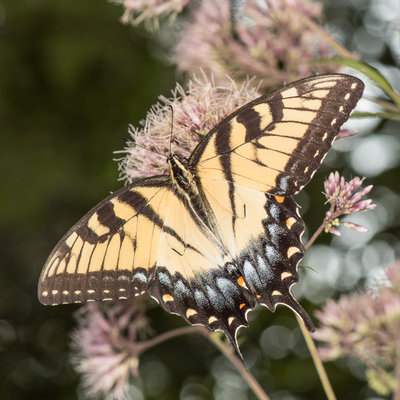
Holm Design & Consulting LLC
Family: Papilionidae (Swallowtails)
Latin name: Papilio glaucusCommon name: Eastern tiger swallowtail butterfly
Distribution: Eastern North America, from central Minnesota eastward to New England and southward to Texas in the west and Florida in the east
Habitat: Woodland edges, gardens, meadows, prairies, old fields and farms
Shown: A female visits sweet Joe Pye weed (
Eutrochium purpureum).
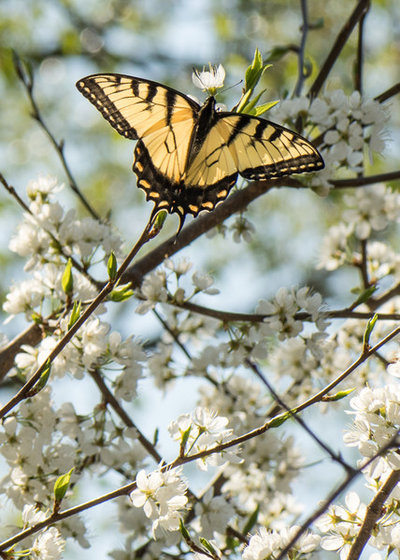
Holm Design & Consulting LLC
When to look for them: In the northern part of their range, the first adults are active in late April or early May, with butterflies in the southern part of their range becoming active earlier. With three generations in the southern part of the range and two, sometimes three, generations in the north and east, adults can be observed from spring until late August or early September.
Shown: A male visits wild plum (
Prunus americana).
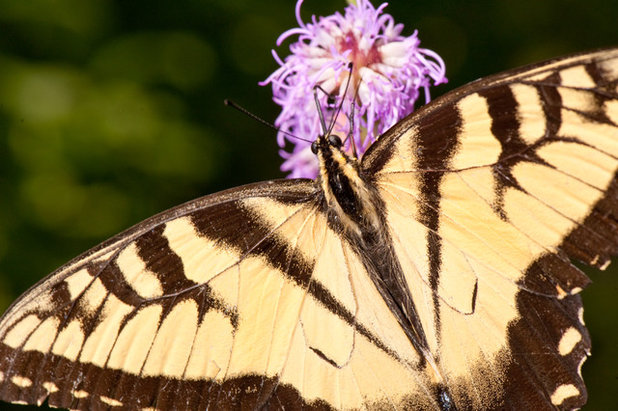
Holm Design & Consulting LLC
How They HelpAdults visit flowering plants for nectar throughout the summer. Eastern tiger swallowtails are one of the largest butterflies in the Northeast; compared with smaller butterflies, these swallowtails have more surface area (larger wings) that often comes into contact with pollen while they forage on flowers. For this reason, they’re considered pollinators in some cases.
Shown: A male forages on tall blazing star (
Liatris aspera).
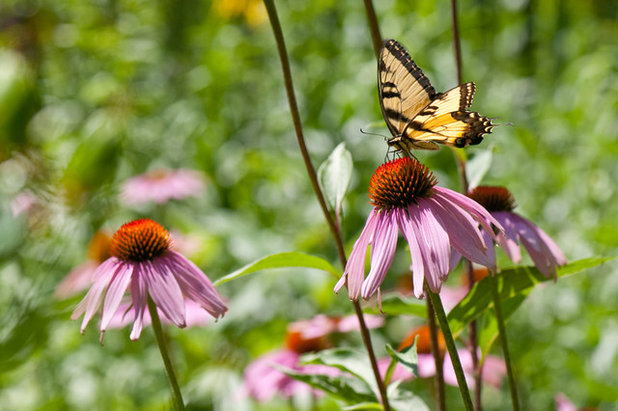
Holm Design & Consulting LLC
How to Spot Eastern Tiger Swallowtail ButterfliesAdults. These large yellow-and-black butterflies are conspicuous and hard to miss as they visit flowers or fly through a garden. Adults have a wingspan of just over 3 to 5½ inches (7.6 to 14 centimeters). Males and females are yellow with tiger-like black stripes. Both males and females have orange and blue spots on the lower hind wings, but females also have prominent blue scaling. A black color form also occurs for females, as seen in the next photo. This form is less abundant in the northern part of the range and more common in the south. Females can be observed flying at treetop heights in the summer, likely looking for appropriate host plants to lay their eggs.
Babies (larvae or caterpillars). Caterpillars have different coloration patterns depending upon their age, measured in growth stages called instars. During the first three instars, they’re dark brown with white splotches — this coloration pattern resembles bird droppings, an effective camouflage to protect the caterpillars from predators. Caterpillars in the fourth instar change color to a light green and have large eyespots on the thorax. The eyespots are another way the caterpillars may ward off potential predators.
Shown: An adult forages on purple coneflower (
Echinacea purpurea).
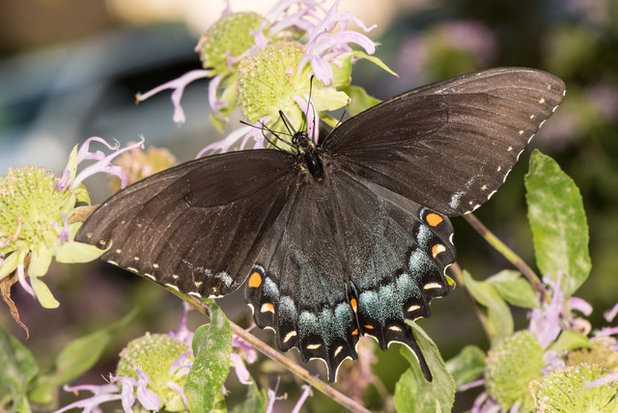
Holm Design & Consulting LLC
How to Lure ThemMaintain a pesticide-free yard. Don’t use pesticides, especially insecticides, in the garden, particularly on flowering plants or larval host plants.
Provide larval host plants for caterpillars. Besides maintaining a pesticide-free garden and continuous succession of flowering plants, you’ll need to provide larval host plants (the plants caterpillars feed upon). Caterpillars feed on the foliage of woody native plant species including ash trees (
Fraxinus spp.), black cherry trees (
Prunus serotina), magnolia trees (
Magnolia spp.) and tulip trees (
Liriodendron tulipifera).
Shown: A female with the black form visits wild bergamot (
Monarda fistulosa).
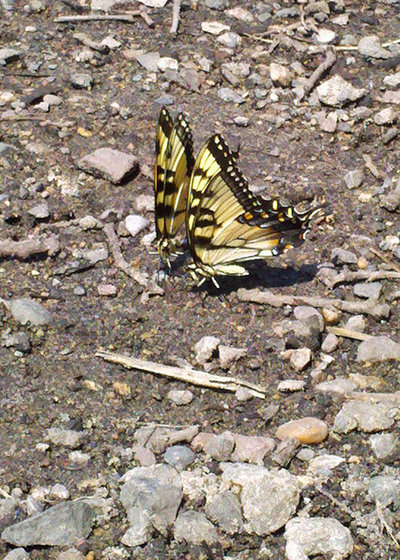
Holm Design & Consulting LLC
Provide moist bare soil for puddling. Besides gleaning energy from nectar, butterflies (particularly males) need minerals and nutrients from moist soil. Male swallowtails will puddle in aggregations, inserting their proboscis into the moist soil to draw up water and minerals.
Offer forage plants for adults. Nectar is one of a few sources of food for adult butterflies. By providing flowering plants continuously throughout the growing season, you’ll ensure that a sufficient amount of nectar is available for adults. Due to their large size, Eastern tiger swallowtails can’t forage easily on small flowers or ones with weak stalks. They therefore tend to show a preference for large flower heads that they can perch from or cling to.
Sample plant list for adults:- Spring: Wild plum (Prunus americana)
- Summer: Buttonbush (Cephalanthus occidentalis), cup plant (Silphium perfoliatum), milkweed (Asclepias spp.), phlox (Phlox spp.), purple coneflower (Echinacea purpurea), spotted Joe Pye weed (Eutrochium maculatum), sweet Joe Pye weed (Eutrochium purpureum) and wild bergamot (Monarda fistulosa)
- Late summer and fall: blazing star (Liatris spp.), aster
Browse native plants for your region
Shown: An adult visits white prairie clover (
Dalea candida).
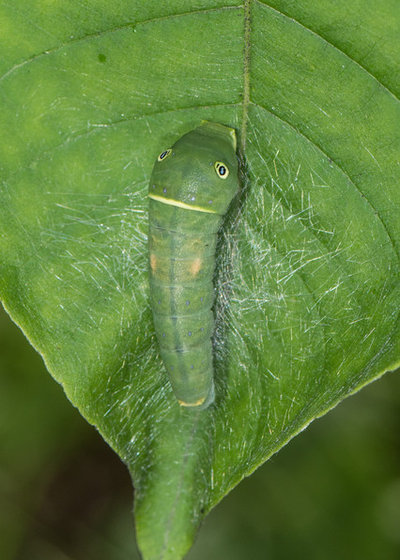
Holm Design & Consulting LLC
Life CycleAfter pupating in a chrysalis, male and female adult butterflies mate. Females then look for host plants, where they lay a single egg on the upper side of a leaf. In the northern part of its range, first-generation caterpillars mature in mid-to-late June; second-generation caterpillars are common in mid-July through August.
The caterpillar hatches and begins feeding on the host plant. It undergoes five growth stages (instars), molting its skin four times between instars. Fourth-instar caterpillars change color to a foliage green and will web themselves on the tops of leaves as they rest, as seen in this photo.
Once the caterpillar is ready to pupate, it changes color to light brown and crawls down from the tree canopy to pupate close to or on the ground. Caterpillars pupate on tree bark or in leaf litter, where the brown backdrop provides camouflage for the light brown caterpillar and light brown chrysalis.

Holm Design & Consulting LLC
Shown: An adult male spreads striped wings.
Region by region: What to do in your garden this month
6 Steps to Creating Your Butterfly Garden





